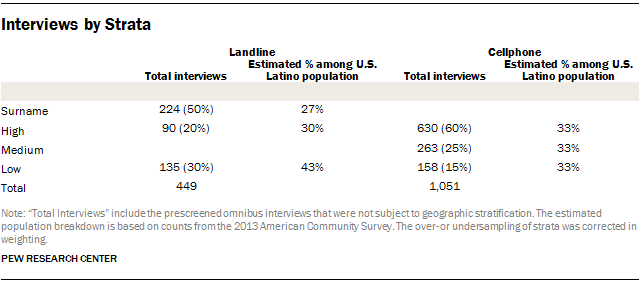Data sources
Unless otherwise noted, all estimates for Hispanics come from Pew Research Center’s National Survey of Latinos, while estimates for whites and blacks are derived from other Pew Research Center surveys.
Questions about technology have been modified over time. Prior to 2015, internet and email use were asked as two separate questions. Internet use read “Do you use the internet, at least occasionally?” Email use read “Do you send or receive email, at least occasionally?” and was asked of those who said “No” or “Don’t know/Refused” to internet use. Those who said they used the internet, email or both were considered internet users. For 2015, internet users are defined as someone who said “yes” to either “Do you use the internet or email, at least occasionally?” or “Do you access the internet on a cellphone, tablet or other mobile handheld device, at least occasionally?”
Cellphones were included in survey samples beginning in 2008.
Methodology
Results for this study are based on telephone interviews conducted by SSRS, an independent research company, for Pew Research Center among a nationally representative sample of 1,500 Latino respondents ages 18 and older. It was conducted on cellular and landline telephones from Oct. 21 through Nov. 30, 2015.
For the full sample, a total of 632 respondents were U.S. born (excluding Puerto Rico), and 868 were foreign born (including Puerto Rico). For results based on the total sample, one can say with 95% confidence that the error attributable to sampling is plus or minus 3.3 percentage points.

For this survey, SSRS used a staff of bilingual English- and Spanish-speaking interviewers who, when contacting a household, were able to offer respondents the option of completing the survey in either language. A total of 679 respondents (45%) were surveyed in Spanish, and 821 respondents (55%) were interviewed in English. Any person ages 18 or older who said he or she was of Latino origin or descent was eligible to complete the survey.
To ensure the highest possible coverage of the eligible population, the study employed a dual-frame landline/cellular telephone design. The sample consisted of a landline sampling frame (yielding 449 completed interviews) and a cellphone sampling frame (1,051 interviews). 7 Both the landline and cellphone sampling frames used a stratified sampling design, oversampling areas with higher densities of Latino residents. Overall the study employed six strata. Landline and cellphone samples were provided by Marketing Systems Group (MSG).
For the landline sampling frame, the sample was compared with InfoUSA and Experian landline household databases, and phone numbers associated with households that included persons with known Latino surnames were subdivided into a surname stratum. The remaining, unmatched and unlisted landline sample was used to generate a stratum with a high incidence of Latinos, based upon the share of Latinos in the sample telephone exchange.
It is important to note that the existence of a surname stratum does not mean the survey was exclusively a surname sample design. The sample is RDD (random-digit dial), with the randomly selected telephone numbers divided by whether or not they were found to be associated with a Spanish surname. This was done to ease administration by allowing for more effective assignment of interviewers and labor hours, as well as to increase the efficiency of the sample.
MSG’s GENESYS sample generation system was used to generate the cellphone sample, which was divided into high and medium strata, based upon the share of Latinos in the sample telephone area code.
Samples for the low-incidence landline and low-incidence cell strata were drawn from previously interviewed respondents in SSRS’s weekly dual-frame Excel omnibus survey. Respondents who indicated they were Latino on the omnibus survey were eligible to be re-contacted for this survey. Altogether, a total of 293 previously interviewed respondents were included in this sample.

A multistage weighting procedure was used to ensure an accurate representation of the national Hispanic population.
- An adjustment was made for all persons found to possess both a landline and a cellphone, as they were more likely to be sampled than were respondents who possessed only one phone type. This adjustment also took into account the different sampling rate in the landline and cellphone samples.
- The sample was corrected for a potential bias associated with re-contacting previously interviewed respondents in low-incidence strata.
- The sample was corrected for within-household selection in landline interviews, which depended upon the number of Latino adults living in the household.
- The sample was corrected for the oversampling of telephone number exchanges known to have higher densities of Latinos and the corresponding undersampling of exchanges known to have lower densities of Latinos.
- Finally, the data were put through a post-stratification sample balancing routine. The post-stratification weighting utilized estimates of the U.S. adult Hispanic population based on the 2013 U.S. Census Bureau’s American Community Survey, on gender, age, education, Census region, heritage and years in the U.S. Phone status of the U.S. adult Hispanic population (i.e., cellphone only, dual/landline only) is based on estimates from the January-June 2015 National Health Interview Survey conducted by the U.S. Centers for Disease Control and Prevention; the density of the Latino population is from the 2010 census.
- Weights are then trimmed to avoid any particular case having too much influence on the overall estimates.
Pew Research Center undertakes all polling activity, including calls to mobile telephone numbers, in compliance with the Telephone Consumer Protection Act and other applicable law.




